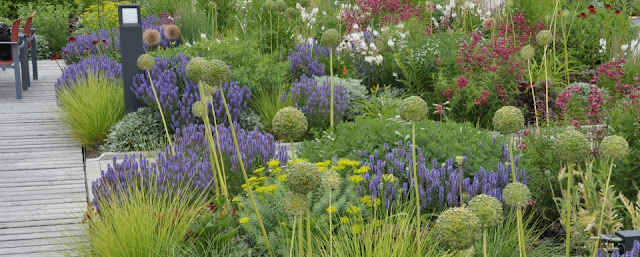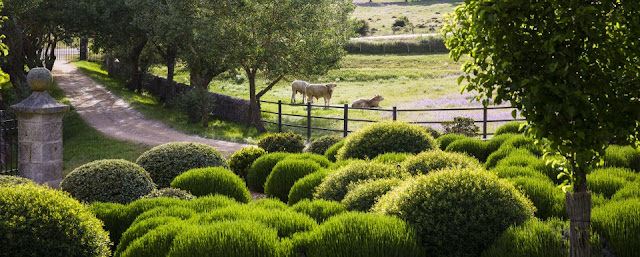Melbourne Landscape Conference
All week I kept wondering how I can write a post about this experience. Over the weekend I spent about 14 hours raptly listening to highly creative landscape architects and garden designers from all over the world. They talked about their ideas, their sources of inspiration and how they work.
It was the Australian Landscape Conference. The theme was Design with Nature: Reconnecting People and Place. It was a big investment for me time and money wise, but it was worth it.
Most of the speakers talked about creating environments for humans that incorporate flora and fauna in an integrated way that relates to the broader landscape - the specific cultural, historical and physical contexts of a place.
The speakers are all highly influential people at the cutting edge of developing contemporary landscapes that take into account the challenges and opportunities the human species faces today and in the future. They are radical in their ideas and practice, questioning the role and meaning of the built environment and its relationship with the natural environment.
Here are a few of the visual highlights, taken from the Conference brochure.
Professor Cassian Schmidt, from Germany, combines perennials and grasses in myriad ways, to replicate natural plant habitats. He is exploring a formulaic planting scheme to help people cope with the challenge of using ever changing perennials.
Bernard Trainor, originally from Melbourne, now lives and works in California. He creates gardens that perfectly reflect their setting. He learned about California's native plants, rocks, soil, topography, architecture and history to design gardens that belong in their specific place.
Andy Sturgeon, award winning British garden designer, has completed projects around the world, public and private. He is passionate about design - not only gardens, but furniture, set design and architecture. He believes we have a lot to learn from history, and that the best materials in contemporary gardens are natural traditional materials like stone, concrete and timber.
It was the Australian Landscape Conference. The theme was Design with Nature: Reconnecting People and Place. It was a big investment for me time and money wise, but it was worth it.
Most of the speakers talked about creating environments for humans that incorporate flora and fauna in an integrated way that relates to the broader landscape - the specific cultural, historical and physical contexts of a place.
The speakers are all highly influential people at the cutting edge of developing contemporary landscapes that take into account the challenges and opportunities the human species faces today and in the future. They are radical in their ideas and practice, questioning the role and meaning of the built environment and its relationship with the natural environment.
Here are a few of the visual highlights, taken from the Conference brochure.
Professor Cassian Schmidt, from Germany, combines perennials and grasses in myriad ways, to replicate natural plant habitats. He is exploring a formulaic planting scheme to help people cope with the challenge of using ever changing perennials.
Dr Kate Cullity, leading Australian landscape architect, founding partner in TLC, designed (among other things) the magnificent Australian Garden, shown in a post in this blog. She sees herself as poetically interpreting the landscape. The above photos show a private garden and a fernery.
Dr Noel Kingsbury, British garden designer and prolific writer, promotes a naturalistic approach to planting design.
Miguel Urquijo is Spanish. He has developed gardens to be sustainable in a Mediteranean climate with dry, hot summers. Even in summer a garden needs to be beautiful, he believes. To achieve this, shrubs dominate, and perennials play only a small role.
I took this on board in relation to my amateur garden, that tends to look pathetic in summer!
Outstanding major projects by Kathryn Gustafson, North American landscape architect, can be seen globally. She sees herself as sculpting the landscape. She works closely with architects and other disciplines - designers, botanists, horticulturalists and engineers.
The above photo is part of the design of the National Botanic Gardens of Wales. Light and shadow is an important part of the design.
Sam Cox is not an international figure like the other speakers. He is very influential locally. He works in Melbourne and its surrounds, and is passionate about the Australian bush. He is involved in both the design and construction of his projects. His naturalistic designs include natural looking swimming that merge seamlessly with the wider environment.
I haven't done justice to the many and varied achievements of these landscape people. Consider this to be a brief appetizer. If you want to continue the meal, just follow the links.










Congratulations for attending this conference. Gardening with nature is increasingly important as we gobble up more and more land and if we can just convince people to adapt to the environment and not impose foreign organisms we can can help wildlife, the ecosystem and ourselves enormously. In our own case we took out all the lawns at our house and replaced everything with native perennials and native trees. We plated a Sugar Maple and a Balsam Fir at the back, and an American Basswood at the front. Our flowers are New England Aster, Black-eyed Susan, Echinacea, ferns etc. The wildlife has increased exponentially. And this is in a conventional suburban backyard.
ReplyDeleteInteresting to hear about your suburban back yard, David. I have done the same, got rid of grass and planted a fair few natives and indigenous plants, but I've included exotics from similar climate zones to Melbourne, like California and the Canary Islands. Endlessly experimenting ...
DeleteI think you have had a great experience, catmint. I've never supposed it was the waste of time when I can learn something more about landscape and gardening. I like the last photo of designer San Cox, nice pond and greenness round it. Of course your garden is nice, because is made by yourself, it's your hard work. When I see works of landscapers I try to place them on the space I have. Often my decision is better than theirs.
ReplyDeleteThanks for this comment, Nadezda. It's very thought provoking. I have been thinking one difference between how we garden and those top professionals is that they have to come up with a finished product, whereas we have the luxury of taking it slowly, taking in its future potential even if the picture doesn't look perfect at any given moment. And we can experiment, muck around, have fun, make mistakes that we learn from.
DeleteThis conference captured my attention when I saw it advertised (on The Planthunter I think). I wish I could have attended but, as that wasn't possible, I appreciate the photos and the links. I need to look for the Kingsbury book. My half-acre lot may be big by local standards but I still garden on a much smaller scale than most of the designers you reference.
ReplyDeleteHi Kris, That Kingsbury book looks interesting. He's also written loads more.
DeleteThat must have been utterly fascinating. It is harder to find the right plant to bridge the gap between house and nature reserve - instead of, I'll have the blue one, that's pretty.
ReplyDeleteHi Diana, plant selection is incredibly hard - I agree. But as to the 'right plant' - is there a right plant? I'm wary of 'shoulds' - in and out of the garden.
DeletePS those Sam Cox gardens are covetable!
ReplyDeleteIf I was going to try to emulate any of those designers, it would be Sam Cox too.
DeleteThank you for a very interesting post. I live in Canberra, but I did look longingly at an ad. for this conference, it looked so interesting.....so it was nice to have a breakdown of speakers at the conference.
ReplyDeleteI'm so pleased you found it helpful, Gerrie. Following all those links would probably take at least as long as the conference - a whole weekend, but at least it's an option for us time-poor people.
DeleteWhat a marvelous experience! The photos are lovely. Glad you could enjoy such an enlightening conference.
ReplyDeleteThanks, VW, lovely to hear from you. We both started our blogs around the same time, and who would have thought we're still going 10 + years later!
DeleteWhat a great experience. Design is the most challenging part of gardening for me. I think it's the aspect of having a limited budget and wanting to keep the landscape as close to nature as possible. These are great examples of how to keep things naturalistic. Thank you.
ReplyDeleteHi Beth, I agree - design is challenging, but even if I had the money I don't know if I'd want someone to do if for me.
DeleteReally interesting blog, with lots of links to learning about what's going on in the world of landscape gardening. Relevant to anyone at all interested in aesthetics of the world surrounding us. Thanx!! :)
ReplyDeleteThanks, Batya, lovely to hear from you.
DeleteI was sure I commented, but see that my memory has failed me. Again.
ReplyDeleteWhat an amazing experience.
Design is something I need to pay more attention to - and you can definitely add me to the list of those whose gardens look a tad sad in the sweaty season.
Hi EC, it is depressing to see the garden wilt and droop, but what a joy to look around now and see that nearly all have recovered!
DeleteNot here. Not yet. We are unseasonably warm and still very, very dry.
DeleteThat must have been a wonderful 14 hours. Sounds like heaven for plant lovers. I'm glad you got to attend. Will your garden start to change because of what you learned?
ReplyDelete美しい花々。 素敵な撮影です。
ReplyDeleteI really liked your Information. Keep up the good work. Lawn and garden care melbourne
ReplyDelete